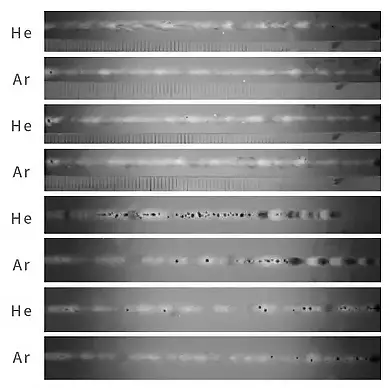Aluminum alloys are valued for their low density, high strength and good corrosion resistance, making them a popular choice in several industries, including automotive, new energy, aerospace and construction.
Laser welding is now a widely used method in the production of aluminum alloy products, providing several benefits over traditional welding methods. These benefits include increased production efficiency, improved weld quality, and the ability to achieve high-precision welding and automate complex structures.
Laser welding is a technology that uses high-intensity laser radiation to melt and recrystallize metal, forming a weld through thermal coupling between the laser and the metal.
Based on the thermal mechanism of laser welding, it can be classified into two types: thermal conduction welding and deep penetration welding.
Thermal conduction welding is mainly used for welding small or precise parts, such as packaging welding or micro/nano welding.
Deep penetration welding, on the other hand, is used to weld materials that require complete penetration. During the welding process, the material vaporizes and a keyhole phenomenon occurs in the weld pool. This method is the most widely used laser welding method today and is the preferred method for welding aluminum alloys.
Features of laser welding:
Advantages of seam laser welding:
- This method is used to weld aluminum alloys without the need for additional materials.
- The welding equipment is simple, without consumables, facilitating automation.
Disadvantages of seam laser welding:
- High requirements for welding clearance, as a small gap can cause the weld to collapse.
- The starting and ending points of welding are prone to forming keyholes.
- The welding process can be unstable, leading to the production of welding defects.
Application example: Building decoration industry – Welding of 5 series aluminum alloy door frames
The inherent physical properties of aluminum alloys, such as low laser absorption, low boiling point of alloying elements, high thermal conductivity, high coefficient of thermal expansion, relatively wide solidification temperature range, high solidification shrinkage, low viscosity and high absorption of hydrogen in liquid, can make it a challenge to produce defect-free laser welds.
One of the most common defects in laser welding of aluminum alloys is porosity, which can damage the integrity of the weld metal, weaken its cross-sectional area and reduce its mechanical and corrosion resistance properties. To prevent porosity and improve the internal quality of the weld, effective measures must be taken.
The way to restrict the gas hole in laser welding
1. Inhibition of welding porosity by surface treatment before welding
Surface treatment before welding is an effective way to control metallurgical pores in laser welding of aluminum alloys. This treatment typically involves physical mechanical cleaning or chemical cleaning.
Weld porosity after different surface treatment methods
After comparison, the best process was chemical treatment, which consists of the following steps: metal cleaning agent cleaning, water washing, alkali washing, water washing, acid washing, water washing and drying.
The alkaline wash step uses a 25% aqueous solution of sodium hydroxide (NaOH) to remove surface material, and the acid wash step uses a 20% aqueous solution of nitric acid (HNO3) and hydrofluoric acid (HF ) at 2% to neutralize residual alkali.
It is important to note that the test plate must be soldered within 24 hours after surface treatment. If the test plate has remained stationary for a long time after treatment, it must be cleaned with absolute alcohol before soldering.
2. Control of welding porosity through welding process parameters
The formation of porosity in the weld depends not only on the quality of the surface treatment, but also on the parameters of the welding process.
The impact of welding parameters on weld porosity is seen mainly in the penetration depth, specifically in the influence of the weld back width ratio on porosity formation.
Effect of weld penetration on weld porosity
The results indicate that when the back width ratio (r) is greater than 0.6, the concentration of chain pores in the weld can be effectively improved. And when the back width ratio is greater than 0.8, the occurrence of large pores in the weld can be effectively reduced and the residual pores in the weld can be largely eliminated.
3. Control welding porosity by choosing the appropriate shielding gas and flow rate
The choice of shielding gas has a direct impact on the quality, efficiency and cost of welding.
In laser welding, proper flow of shielding gas can effectively reduce the porosity of the weld.

Effect of different types of shielding gases on weld porosity
As shown in the figure, argon (Ar) and helium (He) are used as shielding gases to protect the weld surface during laser welding.
The difference in the degree of ionization between Ar and He at the laser affects weld formation. The results show that the porosity in welding with Ar as shielding gas is lower than in welding with He as shielding gas.
It is important to note that a low gas flow rate (< 10L/min) can result in a large amount of plasma being produced and not being effectively expelled, leading to an unstable welding puddle and a greater likelihood of porosity formation. A moderate gas flow rate (about 15L/min) effectively controls the plasma and provides a good antioxidant effect on the solution pool, resulting in the lowest porosity. On the other hand, a high gas flow rate accompanied by high gas pressure can cause part of the shielding gas to mix into the solution pool, leading to increased porosity.
Porosity reduction in laser welding of aluminum alloys is a challenging problem. Due to the properties of aluminum alloys, porosity cannot be completely eliminated in the welding process, but it can be reduced. Through process optimization before and after welding and experimental analysis, three methods for reducing porosity have been proposed and can be used as a reference by industry colleagues.
























































